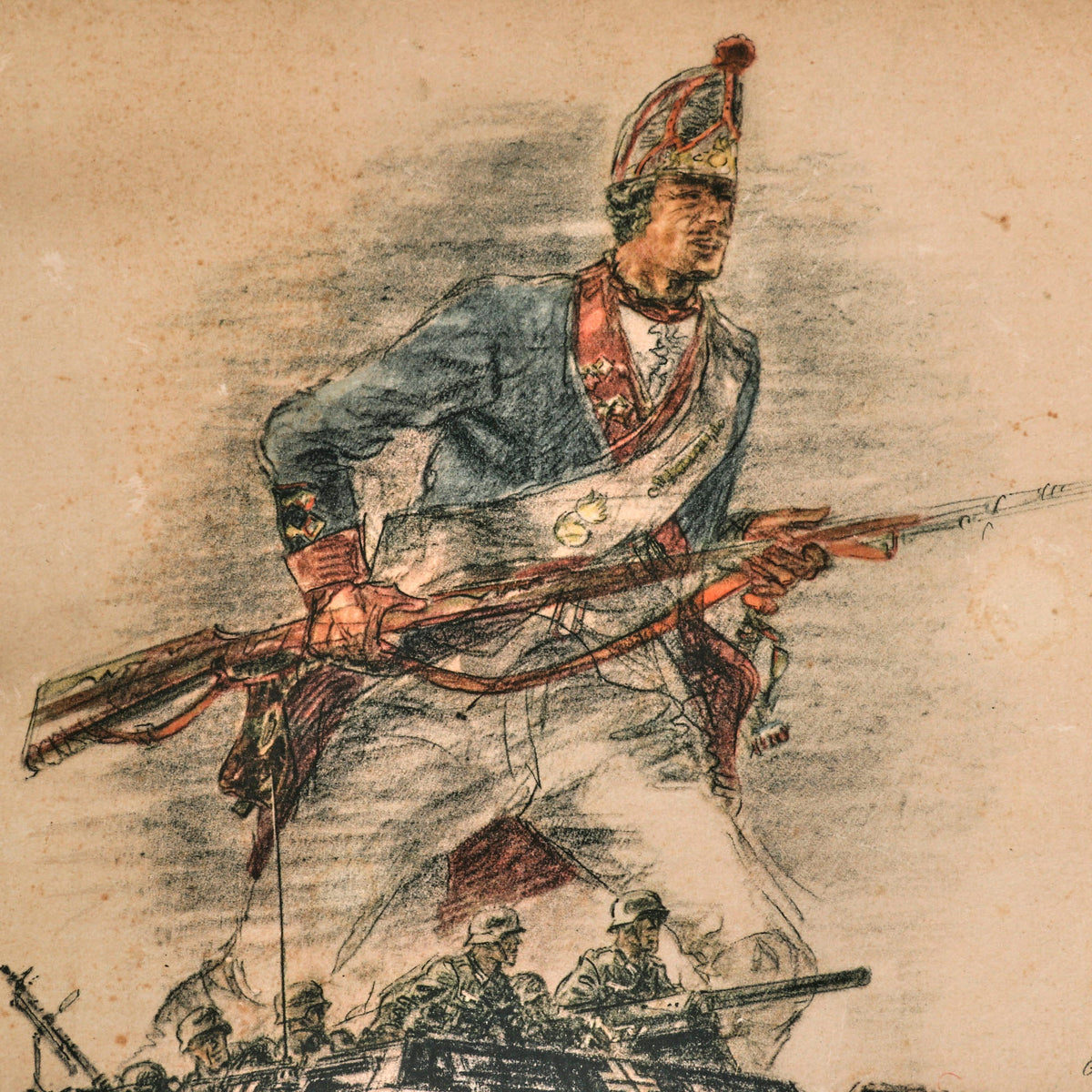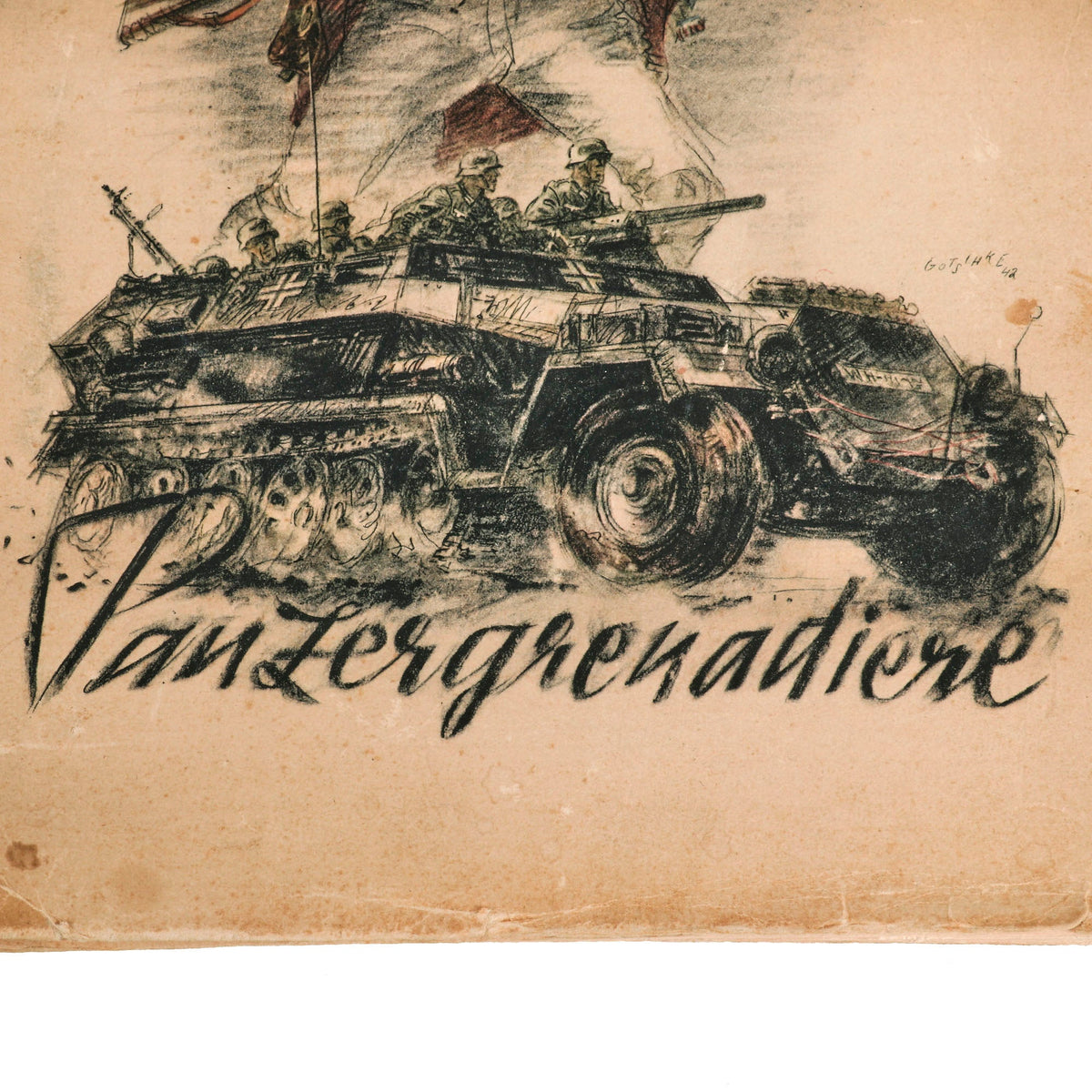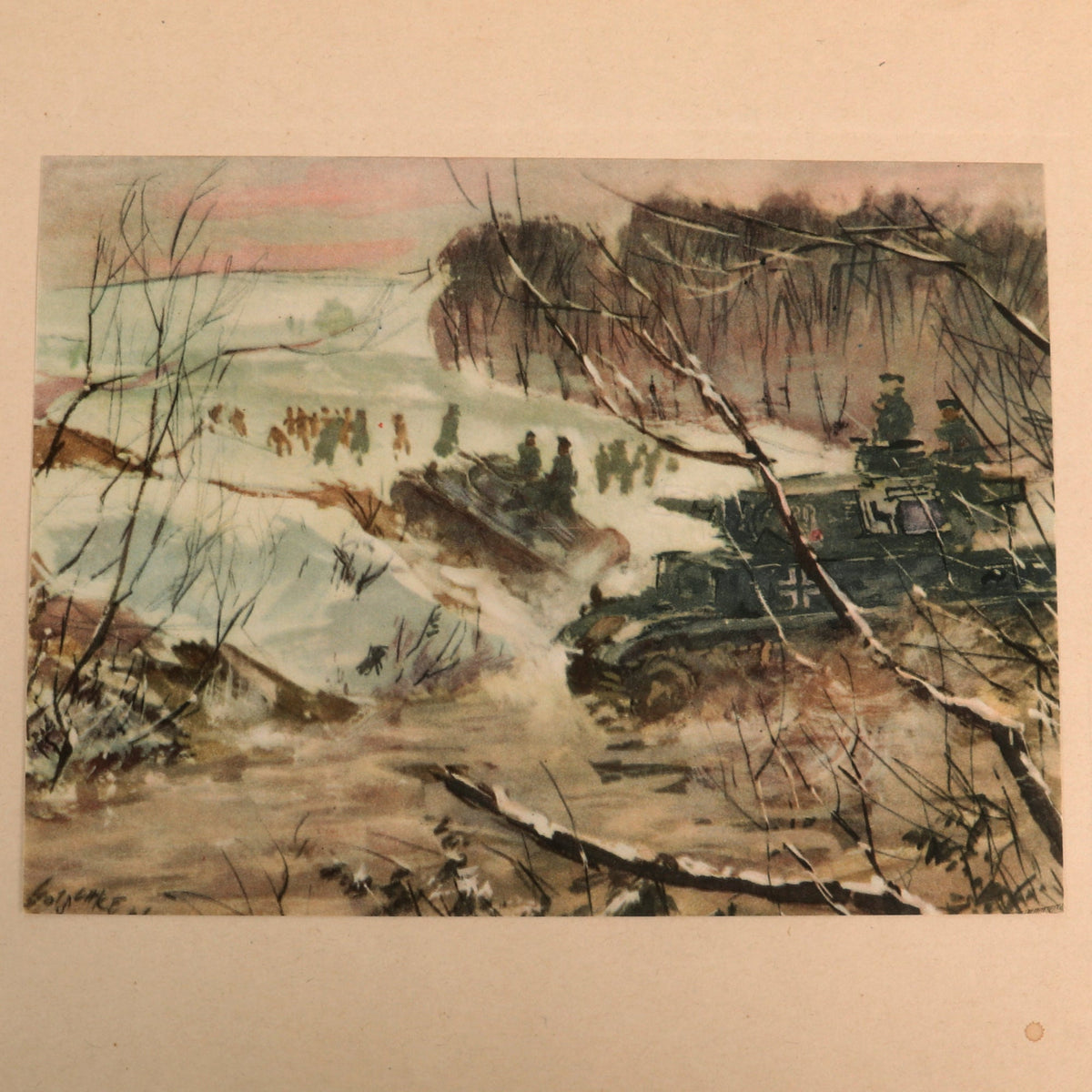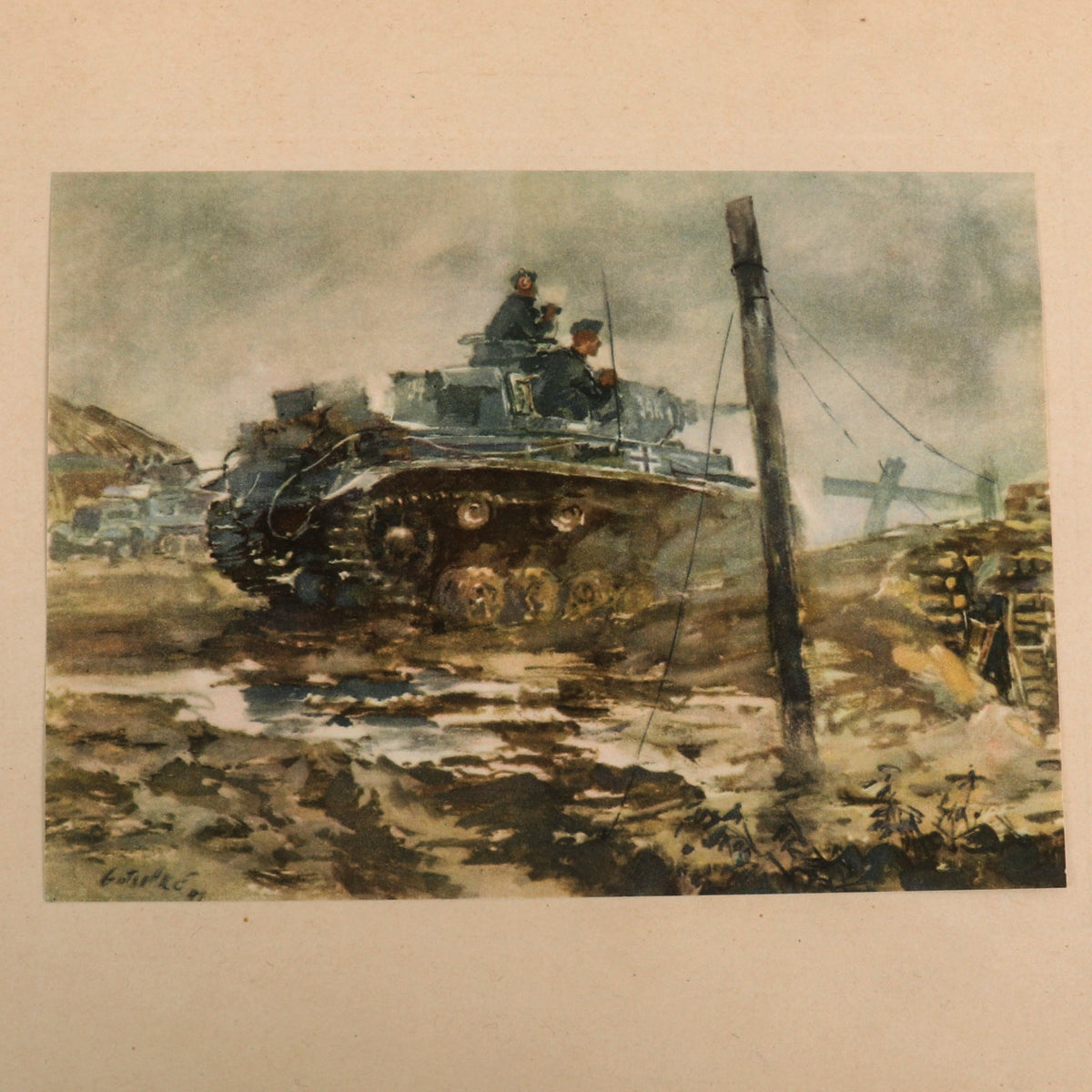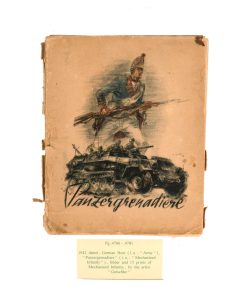Original German WWII 1942 Dated Panzergrenadiere Mechanized Infantry Folder and 15 Prints by Artist Walter Gotschke – Formerly A.A.F. Tank Museum Original Items
$ 495,00 $ 148,50
Original Item: One-of-a-kind Set. A grenadier was historically an explosives engineering assault-specialist soldier who threw hand grenades in siege operation battles. The distinct combat function of the grenadier was established in the mid-17th century, when grenadiers were recruited from among the strongest and largest soldiers. By the 18th century, the grenadier dedicated to throwing hand grenades had become a less necessary specialist, yet in battle, the grenadiers were the physically robust soldiers who led vanguard assaults, such as storming fortifications in the course of siege warfare.
In German history one of the most famous users of these famous soldiers was Frederick the Great, King in/of Prussia and Elector of Brandenberg from 1740 – 1786. As they turned into Elite units during the 19th Century, their fame only grew, so it was natural that the NSDAP, with their desire to link themselves to the past, would hold them in high esteem. Then in 1942 Infantry Regiments were renamed as Grenadier Regiments by AH as a historical homage to Frederick the Great’s Army, and the Schützen were renamed to Panzergrenadiers.
The latter of these were Infantry that served in Panzer regiments during the NSDAP period, often riding in armored transport vehicles. This was much like the Motorisierte Infanterie (motorized infantry) units, so they were also folded under the Panzergrenadier designation, and new units were made. These were given a new Waffenfarbe corps color, Wiesengrün (meadow green), replacing the rosa (rose-pink) or Weiß (white) used previously.
During wartime, to raise the prestige and mythos of the new units and link them to the past, artwork was made showing these elite units in action. This also served to help raise money during the war. These were commissioned from known artists, and for drawing vehicles, there were few more specialized in the art than German artist Walter Gotschke. Born in 1912 in Austrian Silesia, now part of Czechia, he was a self-taught artist, and in 1938 moved to Stuttgart, where he lived for most of the rest of his life. Alongside decades of advertising work for leading European automobile firms, Walter Gotschke’s favourite task was painting automobile races. During his latter period of life this evolved to become his chief activity until in 1985 an eye disease gradually turned into blindness due to old age. In the autumn of 2000 he passed away, leaving a huge body of work.
During WWII, he was commissioned in 1942 to make artwork of Panzergrenadier troops, which was sold in a folder showing a historic German Grenadier as well as the new Panzergrenadier troops, over the word Panzergrenadiere. Inside he folder are 15 prints of various artwork, all signed GOTSCHKE 42, and measuring about 8 to 8 1/2″ wide by 6 inches tall. Some of these look to be in charcoal, while others are water color, or other methods of painting. Each is mounted to a 12 3/4″ x 10 1/4″ backing. The prints are only glued at the top, and have captions underneath.
This wonderful German WWII set of panzergrenadier prints came to us from the American Armoured Foundation, Inc. Tank and Ordnance Memorial Museum. The AAF Tank Museum was a living memorial dedicated to the Tank and Cavalry soldiers of the world. Before 1981 some of the artifacts that make up the AAF Tank Museum was a private collection belonging to Mr. William Gasser. Mr. Gasser felt that his collection would be beneficial in educating present and future generations to the sacrifices made and the technologies gained during war. Therefore, in 1981 the AAF Tank Museum was established as a non-profit charitable organization, and Mr. Gasser’s donated his private collection to the Tank Museum. Mr. Gasser is still active as Volunteer Director and Curator of the Tank Museum and his knowledge of military history has been a great asset to the museum. Unfortunately after 20 years of operation it had to close its doors, which is when this set was acquired.
This wonderful set of prints comes with the display label that used to be under it in the museum, which reads:
1942 dated, German Heer (i.e. : “Army”),
“Panzergrenadiere” (i.e.: “Mechanized
Infantry”), folder and 15 prints of
Mechanized Infantry, by the artist
“Gotschke”
We checked the prints, and the titles / descriptions printed under each are as follows, in the order that they are shown in the photographs, along with basic translations:
● Panzer und Panzergrenadiere im Angriff – “Tanks and Panzergrenadiers attacking”
● Marsch in die Bereitstellung – “Marching into deployment”
● Sicherung – “Backup”
● Unaufhaltsam vorwärts – “Unstoppably forward”
● Panzergrenadiere stürmen in den Kaukasus hinein – “Panzergrenadiers storm into the Caucasus”.
● Pak der Panzergrenadiere im Kampf gegen Feindpanzer – “Pak of the Panzergrenadiers in the fight against enemy tanks”. Pak is short for Panzerabwehrkanone – Anti-tank Cannon.
● Panzergrenadiere brechen den letzten Widerstand – “Panzergrenadiers break the last resistance”
● Befehl von Brigade: Panzer haben Feindstellung durchbrochen Panzergrenadier-Bataillon Verfolgung aufnehmen! – “Order from Brigade: Tanks have broken through enemy position. Panzergrenadier Battalion is in pursuit!”
● Panzergrenadiere sturmen eien wichtigen sowjetischen Bahnhof – “Panzergrenadiers storm an important Soviet train station.”
● Wichtige Meldung erreicht den Kommandeur eines Panzergrenadier-Regiments – “Important message reaches the commander of a Panzergrenadier regiment”
● Abgesessen zum Ortskampf – “Dismounted for local combat”
● Panzergrenadiere in rastlosem Vormarsch – “Panzergrenadiers in a restless advance”
● Schwerer Granatwerfer der Panzergrenadiere im Kampf vom Fahrzeug – “Heavy mortar of the Panzergrenadiers in combat from the vehicle.”
● Einbruch der Panzergrenadiere in eine zah verteidigte sowjetische Ortschaft – “Panzergrenadiers break into a staunchly defended Soviet village.”
● Schwerer Geschutzzug der Panzergrenadiere beim Stellungswechsel vorwärts – “Heavy armored platoon of Panzergrenadiers moving forward when changing positions.”
The prints and their backing are all in good condition, while the folder is in several pieces due to wear, however the cover artwork is definitely still fully visible.
Definitely an interesting and unique piece of WWII Memorabilia! Ready to research and display!
Wehrmacht Panzergrenadiers during World War II
The term Panzergrenadier had been introduced in 1942, and was applied equally to the infantry component of Panzer divisions as well as the new divisions known as Panzergrenadier Divisions. Most of the Heer’s PzGren. divisions evolved via upgrades from ordinary infantry divisions, first to Motorized Infantry divisions and then to PzGren. divisions, retaining their numerical designation within the series for infantry divisions throughout the process. This included the 3rd, 10th, 14th, 15th, 16th, 18th, 20th, 25th, and 29th divisions. Others, such as the Großdeutschland Division, were built up over the course of the war by repeatedly augmenting the size of an elite regiment or battalion. The Waffen-SS also created several PzGren. divisions by the same methods, or by creating new divisions from scratch later in the war. A number of PzGren. divisions in both the Heer and Waffen-SS were upgraded to Panzerwaffe divisions as the war progressed.
The Panzergrenadier divisions were organized as combined arms formations, usually with six battalions of truck-mounted infantry organized into either two or three regiments, a battalion of tanks, and an ordinary division’s complement of artillery, reconnaissance units, combat engineers, anti-tank and anti-aircraft artillery, and so forth. All these support elements would also be mechanized in a PzGren. division, though most of the artillery, anti-tank, and anti-aircraft elements were equipped with weapons towed by trucks rather than the relatively rare armored and self-propelled models. In practice the PzGren. divisions were often equipped with heavy assault guns rather than tanks, one armoured regiment with three battalions of 14 assault guns each,[3] due to a chronic shortage of tanks throughout the German armed forces. A few elite units, on the other hand, might have the tanks plus a battalion of heavy assault guns for their anti-tank element, and armored carriers for some of their infantry battalions as well.
On paper a Panzergrenadier division had one tank battalion less than a Panzer division, but two more infantry battalions, and thus was almost as strong as a Panzer division, especially on the defensive. Of 226 panzergrenadier battalions in the whole of the German Army, Luftwaffe and Waffen SS in September 1943, only 26 were equipped with armoured half tracks, or just over 11 percent. The rest were equipped with trucks.
Fast Shipping with Professional Packaging
Thanks to our longstanding association with UPS FedEx DHL, and other major international carriers, we are able to provide a range of shipping options. Our warehouse staff is expertly trained and will wrap your products according to our exact and precise specifications. Prior to shipping, your goods will be thoroughly examined and securely secured. We ship to thousands clients each day across multiple countries. This shows how we're dedicated to be the largest retailer on the internet. Warehouses and distribution centres can be located throughout Europe as well as the USA.
Note: Orders with more than one item will be assigned a processing date depending on the item.
Before shipping before shipping, we'll conduct a thorough inspection of the items you have ordered. Today, the majority of orders will be delivered within 48 hours. The delivery time will be between 3-7 days.
Returns
The stock is dynamic and we cannot completely manage it because multiple stakeholders are involved, including our factory and warehouse. So the actual stock may alter at any time. It's possible that you may not receive your order once the order has been made.
Our policy is valid for a period of 30 days. If you don't receive the product within 30 days, we are not able to issue a refund or an exchange.
You can only return an item if it is unused and in the same state as the day you received it. You must have the item in its original packaging.
Related products
Uncategorized
Uncategorized
Uncategorized
Uncategorized
Uncategorized
Armoured Fighting Vehicles of the World: AFVs of World War One (Hardcover Book) New Made Items
Uncategorized
Uncategorized
Uncategorized
Uncategorized
Uncategorized
Uncategorized
Uncategorized
Uncategorized
Uncategorized
Uncategorized
Uncategorized
Armored Burgonet Helmet & Polearm from Scottish Castle Leith Hall Circa 1700 Original Items
Uncategorized
Angolan Rebel 1970s era 60mm Inert Display Mortar from Angolan Civil War Original Items

